Payment in India Market Size
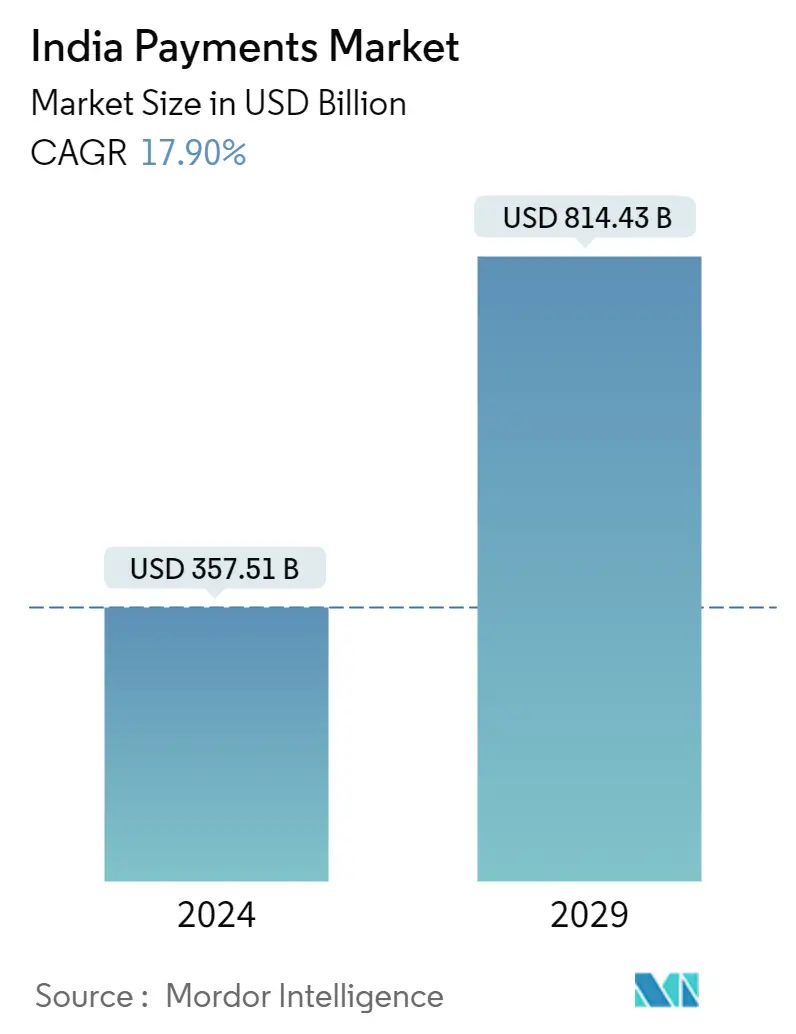
| Study Period | 2019 - 2029 |
| Base Year For Estimation | 2023 |
| Market Size (2024) | USD 357.51 Billion |
| Market Size (2029) | USD 814.43 Billion |
| CAGR (2024 - 2029) | 17.90 % |
| Market Concentration | Medium |
Major Players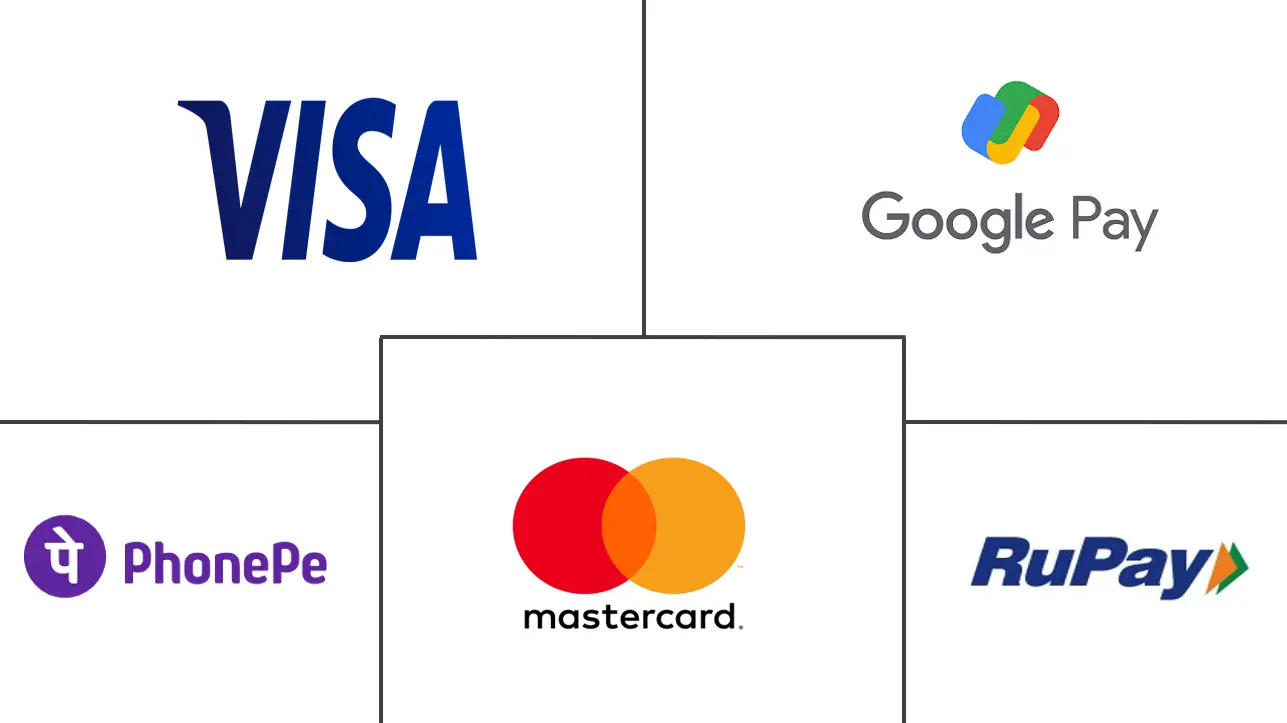
*Disclaimer: Major Players sorted in no particular order |
Payment in India Market Analysis
The India Payments Market size is estimated at USD 357.51 billion in 2024, and is expected to reach USD 814.43 billion by 2029, growing at a CAGR of 17.90% during the forecast period (2024-2029).
The primary factor driving the growth of the market in the region is the rising adoption of digital payments supported by government initiatives and strong growth in E-commerce, among others.
- The Indian payments market is evolving from cash as the primary mode of payment and usage of debit cards being limited to cash withdrawals to the digital payments system. The Indian payment market has evolved to widespread adoption of multiple payment products and systems like Prepaid Payment Instruments (PPIs), Quick Response (QR) code, Immediate Payment Service (IMPS), real-time payment system Unified Payments Interface (UPI), and Aadhar enabled Payment Service (AePS).
- Various initiatives by the Government of India, such as digital India, are further driving the adoption of digital wallets and digital payments in the region. Also, as per Union Budget 2022-23, to boost India's digital economy, the Reserve Bank of India (RBI) will be launching the Central Bank Digital Currency (CBDC) as India's official digital Rupee, which is further expected to strengthen the Indian payments market.
- Moreover, growth in digital payments in the region has been primarily driven by factors such as the launch of new and innovative payment products by the payment companies, the rising need for faster payment modes, and a strong push from the Government and regulators toward the adoption of digital channels.
- The Indian real-payment segment continuously witnessed substantial growth over the past few years. The Immediate Payment Service (IMPS) from the National Payment Corporation of India (NPCI) drives an ever-expanding suite of API-overlay services through the UPI. The Unified Payments Interface (UPI) is a payment system that powers various bank accounts into a single mobile application, merging several banking features, seamless fund routing and merchant payments into one hood. It also caters to the peer-to-peer collection request, which can be scheduled and paid as per requirement and convenience. Furthermore, Buy Now Pay Later real-time payments services have been rising for the past few years in the region.
- Banks are now more focused on providing integrated solutions for payment solutions to their consumers. Digital payments systems have evolved from being viewed as a cost center for banks to a revenue center and a key parameter for customer acquisition. Many banks in the region have introduced their own digital payment app to gain more customer acquisition, such as BHIM Axis Pay, Yono by SBI, HDFC PayzApp, Pockets By ICICI Bank, etc.
- However, failed transactions are increasing with the rising number of transactions and technical declines in the region. The rise in UPI payment transactions also tests the banking infrastructure and technological systems, which are not adequately equipped to handle the surge in volumes. The Reserve Bank of India, with the NPCI, is pushing the banks to reduce technical failures and work on a real-time system for handling customer complaints.
- During the COVID-19 pandemic, India has seen lockdowns across the country and cash payments declined during this period. However, even before the pandemic, the country was moving towards a cash-free society, and the pandemic further proliferated the move. Digital payments, app-based payments, and real-time payments grew in the region to avoid the physical contact spread of the virus during the outbreak.
Payment in India Market Trends
This section covers the major market trends shaping the India Payments Market according to our research experts:
Robust Growth of E-commerce and Rise of M-commerce is Expected to Drive the Payments Market
- India's e-commerce market continues to see strong growth rates propelled by rising smartphone penetration, rising internet penetration, and increasing consumer wealth. E-commerce increasingly attracts customers from tier II and tier III cities where people have limited access to brands but have high aspirations. The rise in E-commerce is further supported by the rising use of digital payments and Buy Now Pay Later services in the region.
- Digital payments are emerging as the preferred E-commerce payment method and are further expected to retain the majority share in the coming years; local digital wallets such as Paytm, MobiKwik, and PhonePe compete with Google Pay, Amazon Pay, and others for this growing E-commerce market.
- Furthermore, real-time payment services like Buy Now Pay Later are gradually making their way as popular payment checkout solutions as an alternative to credit cards for the E-commerce market. The E-commerce giants in the region, such as Flipkart and Amazon, offer Flipkart Pay Later and Amazon Pay Later services to the consumers in the region, further paving the way for the popularity of real-time payment services in the E-commerce market.
- Moreover, the region has witnessed a rising trend in the adoption of mobile commerce in the past few years. Online retailers in the region are their growing reach in towns and cities beyond metros is driven by increased usage of mobile internet. Increased ownership of smartphones is helping more Indians access shopping websites quickly on their phone. Further supported by the variety of payment checkout solutions available such as UPI, Phonepe, Paytm, and Amazon Pay on their mobile.
- Furthermore, many leading banks in the country, such as SBI, HDFC, ICICI, AXIS, etc., offer customer-friendly online shopping credit card deals ensuring value addition. Many banks in the region have tie-up with E-commerce giants to provide credit cards, which provide excellent value addition on online shopping, such as Flipkart Axis bank credit card, ICICI Amazon Pay credit card, HDFC Regalia credit card, Etc. These type of credit cards offers discounts and rewards for online shopping to the credit cardholders, further boosting the use of credit cards for online shopping in the region.
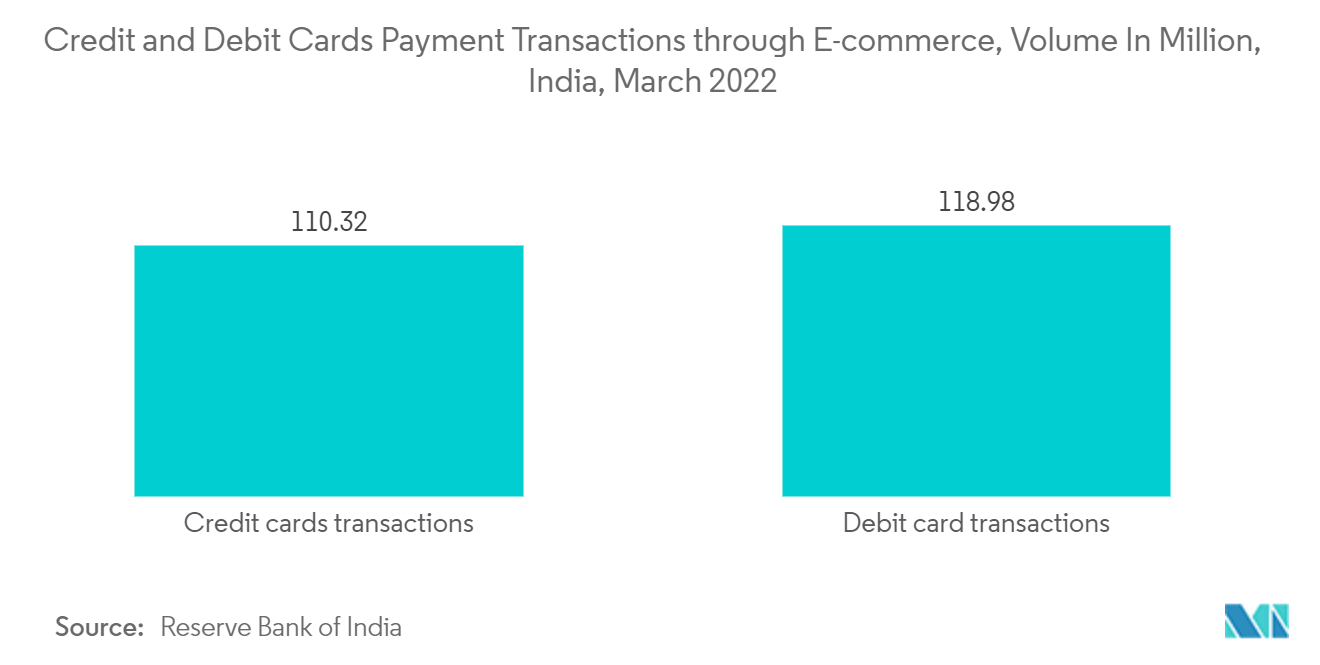
Real-Time Payment Systems segment are expected to gain significant traction
- UPI has proven to make the lives of many Indian users much easier. UPI is a popular real-time payment method that allows users to transfer funds from one bank account to the other instantly. There are several benefits associated with the UPI payments system, such as hassle-free online payments anywhere, a safe and secure mode of money transfer, and Users can make payments by scanning QR codes. These factors resulted in the dramatic rise of the UPI payments system as a preferred payment system in India.
- Some unique aspects of UPI payment include decoupling the funding source's payment address, further growing its adoption among Indian consumers. A UPI ID relates a merchant or an individual to their bank account and removes the need to share bank account details while initiating a fund transfer. Users can easily reassign the payment address to another bank account at any time without the hassle of informing their transacting parties, and thus UPI redefines customer relationships with banks.
- Moreover, almost every bank allows UPI transactions through mobile applications, and the UPI Payment system enables individuals to request money from any other individual, which is not an option with other payment systems like IMPS and NEFT in the region. Further, boosting the growth of the UPI payment system in the Indian payments market.
- Further, UPI is offering benefits not just for banks but also for non-banks. For instance, non-banks in India need to connect with only one sponsor bank to access UPI's central API to transfer and receive money through all UPI participating banks on the system. For example, Google Pay or Amazon Pay in India can instantly initiate a fund transfer request to and from any UPI participating bank. However, the scenario is different for fund transfers in other countries. This openness has made India's payment system a favorite destination for some of the largest technology companies in the world.
- Furthermore, the UPI payment system is further increasing mobile payments by becoming a single user interface for all of an individual's bank accounts, eliminating the need to download multiple banking apps. Most banks and non-banks have adopted the UPI payment system. For instance, as per NPCI data, the number of banks that were live on UPI increased from 220 in April 2021 to 316 in April 2022.
- All of the aforementioned factors are further expected to drive the demand for the UPI payments system in the region over the forecast period.
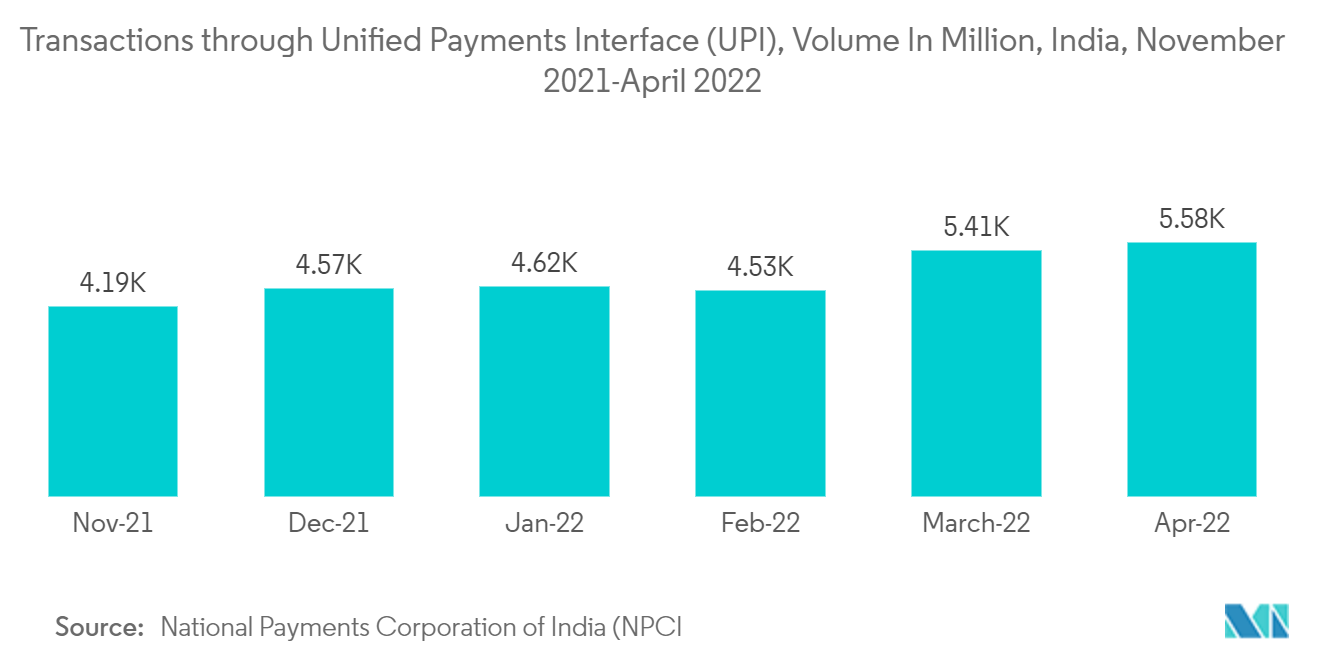
Payment in India Industry Overview
The Indian payments market appears to be moderately consolidated as few of the players currently dominate the payments market. Major players in the Indian payments market are offering well-developed digital payments solutions, adopting strategies like acquisitions and partnerships to expand their reach to more consumers in the region. Some of the major companies in the payments market are Visa Inc., Mastercard Inc., Phonepe Pvt Ltd. (Flipkart Internet Pvt Ltd), Google pay (Google LLC), and Rupay.
- March 2022 - Fintech unicorn Razorpay announced its acquisition of IZealiant Technologies, a leading Fintech startup that provides payments technology solutions for banks, for an undisclosed amount. The acquisition of IZealiant will further strengthen Razorpay's banking solutions arm, helping it to build innovative payment banking technologies for partner banks.
- March 2022 - HDFC Bank announced refurbishing its PayZapp app and launching it as a complete payments app called PayZapp 2.0 on the latest digital technology platform. The bank believes this app will leverage its existing strengths, such as its 60-million-strong debit and credit card franchise. Unlike its earlier version, PayZapp 2.0 will have Unified Payments Interface payments enabled. It will include a range of payment options, including modes like tap and pay to transact at all merchant establishments with the required enablement.
- May 2022 - India's one of the largest private lenders, HDFC Bank, plans to launch a digital platform for merchants between June and September, which will allow them to accept online and offline payments on the lines of China's Alipay. It will enable a small Kirana store to be the local Amazon for its catchment area.
Payment in India Market Leaders
-
Visa Inc.
-
Mastercard Inc.
-
PhonePe Pvt Ltd. (Flipkart Internet Pvt Ltd)
-
Google pay (Google LLC)
-
Rupay
*Disclaimer: Major Players sorted in no particular order
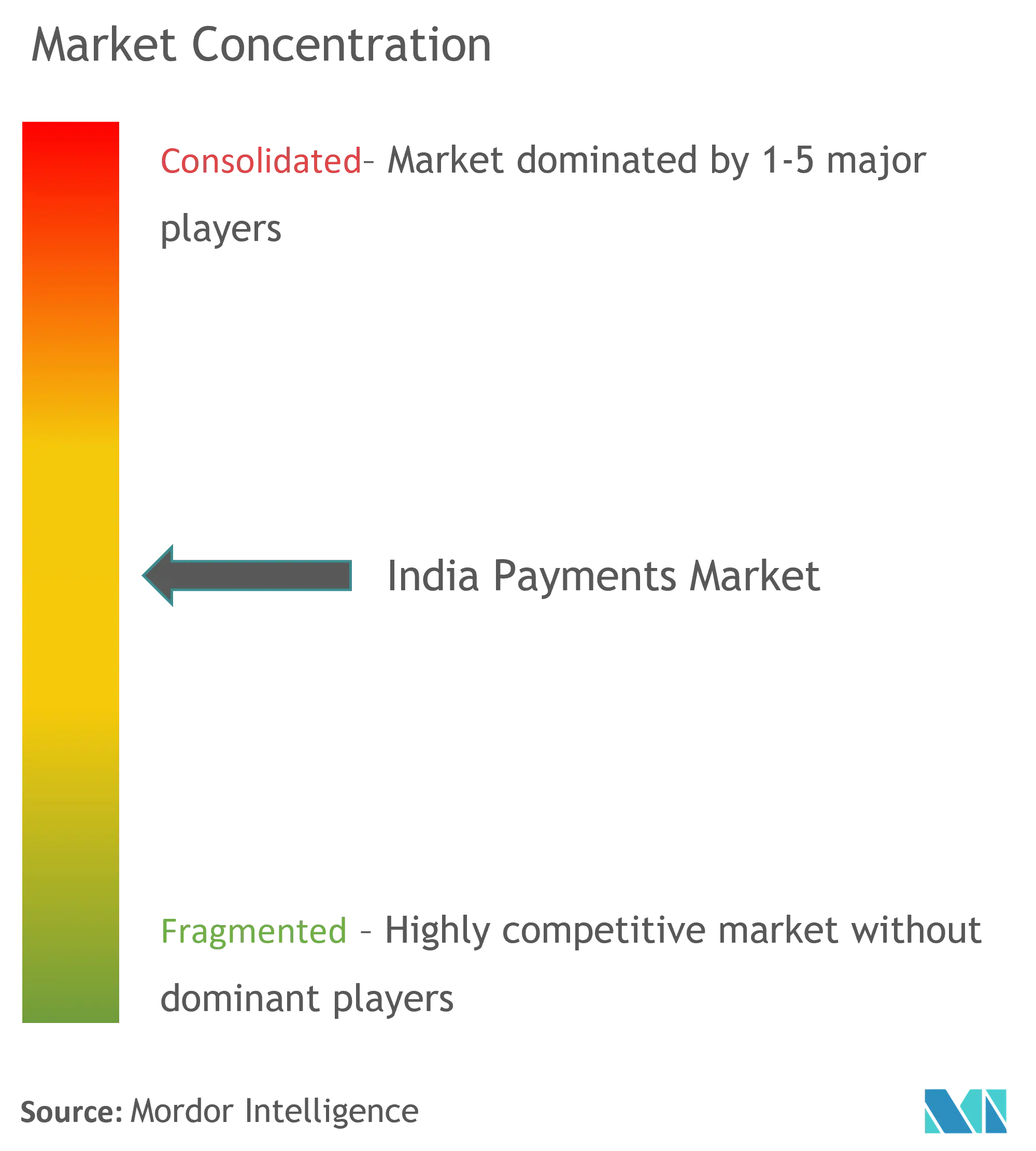
Payment in India Market News
- December 2021 - Indipaisa, a member of the Nexxo Network, an international network of Fintech companies operating in the Middle East, Asia, and Europe, announced to launch of a set of innovative Financial Technology (Fintech) solutions targeting India's flourishing 63 million Small and Mid-sized Enterprise (SME) sector. Indipaisa, in partnership with NSDL Payments Bank, announced the introduction of multiple financial products and services customized from the ground up to match the specific needs of Indian SME owners and operators.
- February 2022 - Razorpay, based out of India, has announced its first international expansion into South-East Asia with the acquisition of a majority stake in Curlec, a Malaysian fintech firm, for an undisclosed amount. Curlec is a Kuala Lumpur-based company building solutions for recurring payments for modern businesses of all sizes. This marks Razorpay's fourth acquisition overall and its first in international waters.
- April 2022 - India Post Payments Bank launched Fincluvation, a platform to promote innovative solutions in collaboration with fintech startups to accelerate financial inclusion among the underserved and unserved population. India Post will invite startups to co-create solutions on the platform. The government will offer up to INR 3 crore to support the entire journey from the proof-of-concept stage to the final product.
- May 2022 - Fintech startup Slice announced the launch of UPI payments for its users as it seeks to become a payment-first product company from a credit-only product company. The UPI payments feature will be available to its waiting list of 10 million customers who have not been able to get access to credit yet and its existing millions of customers.
Payment in India Market Report - Table of Contents
1. INTRODUCTION
- 1.1 Study Assumptions and Market Definitions
- 1.2 Scope of the Study
2. RESEARCH METHODOLOGY
3. EXECUTIVE SUMMARY
4. MARKET INSIGHTS
- 4.1 Market Overview
- 4.2 Industry Stakeholder Analysis
-
4.3 Industry Attractiveness-Porter's Five Force Analysis
- 4.3.1 Bargaining Power of Suppliers
- 4.3.2 Bargaining Power of Buyers/Consumers
- 4.3.3 Threat of New Entrants
- 4.3.4 Threat of Substitute Products
- 4.3.5 Intensity of Competitive Rivalry
- 4.4 Evolution of the payments landscape in India
- 4.5 Key market trends pertaining to the growth of cashless transaction in India
- 4.6 Impact of COVID-19 on the payments market in India
5. MARKET DYNAMICS
-
5.1 Market Drivers
- 5.1.1 Robust Growth of E-commerce and Rise of M-commerce is Expected to Drive the Payments Market
- 5.1.2 Enablement Programs by Key Retailers and Government encouraging digitization of the market
- 5.1.3 Real-time Payments, such as UPI and Buy Now Pay Later to Drive the Indian Payments Market
-
5.2 Market Challenges
- 5.2.1 Higher Rate of Failure in Digital Transactions
-
5.3 Market Opportunities
- 5.3.1 Move towards Cashless Society
- 5.3.2 New Entrants to Drive Innovation Leading to Higher Adoption
- 5.4 Key Regulations and Standards in the Digital Payments Industry
- 5.5 Analysis of major case studies and use-cases
- 5.6 Analysis of key demographic trends and patterns related to payments industry in India (Coverage to include Population, Internet Penetration, Banking Penetration/Unbanking Population, Age & Income etc.)
- 5.7 Analysis of the increasing emphasis on customer satisfaction and convergence of global trends in India
- 5.8 Analysis of cash displacement and rise of contactless payment modes in India
6. Market Segmentation
-
6.1 By Mode of Payment
- 6.1.1 Point of Sale
- 6.1.1.1 Card Payments (includes Debit Cards, Credit Cards, Bank Financing Prepaid Cards)
- 6.1.1.2 Digital Wallet (includes Mobile Wallets)
- 6.1.1.3 Cash
- 6.1.1.4 Others
- 6.1.2 Online Sale
- 6.1.2.1 Card Payments (includes Debit Cards, Credit Cards, Bank Financing Prepaid Cards)
- 6.1.2.2 Digital Wallet (includes Mobile Wallets)
- 6.1.2.3 Others (includes Cash on Delivery, Bank Transfer, and Buy Now, Pay Later)
-
6.2 By End-user Industry
- 6.2.1 Retail
- 6.2.2 Entertainment
- 6.2.3 Healthcare
- 6.2.4 Hospitality
- 6.2.5 Other End-user Industries
7. Competitive Landscape
-
7.1 Company Profiles
- 7.1.1 Visa Inc.
- 7.1.2 Mastercard Inc.
- 7.1.3 PhonePe Pvt Ltd. (Flipkart Internet Pvt Ltd)
- 7.1.4 Google pay (Google LLC)
- 7.1.5 Rupay
- 7.1.6 Paytm(One97 Communications Limited)
- 7.1.7 Amazon Pay (Amazon.com Inc.)
- 7.1.8 American Express Company
- 7.1.9 One MobiKwik Systems Limited
- 7.1.10 Freecharge Payment Technologies Pvt. Ltd
- *List Not Exhaustive
8. Investment Analysis
9. Future Outlook of the Market
** Subject To AvailablityPayment in India Industry Segmentation
The Indian payments market is segmented by mode of payment (point of sale (card payments, digital wallet, cash), online sale (card payments, digital wallet)), and by end-user industries (retail, entertainment, healthcare, hospitality). E-commerce payments include online purchases of both goods and services, such as purchases made on e-commerce websites and online booking of travel and accommodation. The scope of the market excludes online purchases of motor vehicles, real estate, utility bill payments (such as water, heating, and electricity), mortgage payments, loans, credit card bills, or purchases of shares and bonds. As for Point-of-Sale, all transactions that occur at the physical point of sale are included in the scope of the market. It includes traditional in-store transactions as well as all face-to-face transactions, regardless of the location of the transaction. Cash is also considered for both cases (cash-on-delivery for e-commerce sales).
The study tracks key market metrics, underlying growth influencers, and significant industry vendors, providing support for market estimates and growth rates in India throughout the anticipated period. The study looks at COVID-19's overall influence on the Indian payment ecosystem.
| By Mode of Payment | Point of Sale | Card Payments (includes Debit Cards, Credit Cards, Bank Financing Prepaid Cards) |
| Digital Wallet (includes Mobile Wallets) | ||
| Cash | ||
| Others | ||
| By Mode of Payment | Online Sale | Card Payments (includes Debit Cards, Credit Cards, Bank Financing Prepaid Cards) |
| Digital Wallet (includes Mobile Wallets) | ||
| Others (includes Cash on Delivery, Bank Transfer, and Buy Now, Pay Later) | ||
| By End-user Industry | Retail | |
| Entertainment | ||
| Healthcare | ||
| Hospitality | ||
| Other End-user Industries |
Payment in India Market Research FAQs
How big is the India Payments Market?
The India Payments Market size is expected to reach USD 357.51 billion in 2024 and grow at a CAGR of 17.90% to reach USD 814.43 billion by 2029.
What is the current India Payments Market size?
In 2024, the India Payments Market size is expected to reach USD 357.51 billion.
Who are the key players in India Payments Market?
Visa Inc., Mastercard Inc., PhonePe Pvt Ltd. (Flipkart Internet Pvt Ltd), Google pay (Google LLC) and Rupay are the major companies operating in the India Payments Market.
What years does this India Payments Market cover, and what was the market size in 2023?
In 2023, the India Payments Market size was estimated at USD 303.23 billion. The report covers the India Payments Market historical market size for years: 2019, 2020, 2021, 2022 and 2023. The report also forecasts the India Payments Market size for years: 2024, 2025, 2026, 2027, 2028 and 2029.
What are the key trends in the India Payments Market?
Key trends in the Indian Payments Market are a) Rise of digital payments b) Increased adoption of mobile wallets c) Government's push towards a cashless economy
What are the future opportunities in the India Payments Market?
Future opportunities in Indian Payment Market include a) Expansion into rural markets b) Integration with international payment systems c) Development of new payment solutions
Payment in India Industry Report
The Digital Payment Industry Report India is segmented by mode of payment and end-user industries, highlighting the diverse applications across sectors such as retail, entertainment, healthcare, and hospitality. The payment industry in India is experiencing significant growth, driven by the increasing adoption of digital payment methods and government initiatives aimed at promoting a cashless economy. With a diverse range of options including cash, debit cards, credit cards, e-wallets, and prepaid cards, digital transactions are particularly popular among the younger demographic.
The shift from traditional cash-based transactions is supported by the widespread use of smartphones and the internet, alongside innovative payment products that enhance consumer convenience and security. The industry is segmented by methods and verticals, showing extensive application across different sectors. Regional analysis indicates varied adoption rates, with growth opportunities in both urban and rural areas. The competitive landscape features numerous players offering integrated solutions that cater to the evolving needs of consumers and businesses.
Market trends reveal a robust market growth, driven by the increasing market value and the contributions of market leaders. The market segmentation highlights the diverse consumer market, while the market overview provides a comprehensive analysis of the industry's dynamics. The market forecast and market predictions offer insights into future developments, emphasizing the potential for continued expansion.
Industry analysis and industry statistics provide detailed insights into the current state of the market, while industry trends and industry outlook shed light on future prospects. The industry size and industry sales data reflect the market's scale and economic impact. Research companies contribute valuable industry research and industry reports that inform stakeholders about market data and market review.
The report example and report pdf offer accessible formats for stakeholders to understand the market dynamics. The growth rate and market outlook are crucial indicators of the industry's trajectory, while the market review and market segmentation provide a detailed breakdown of different market segments. The industry information and market predictions help stakeholders make informed decisions, ensuring they stay ahead in a competitive market.



